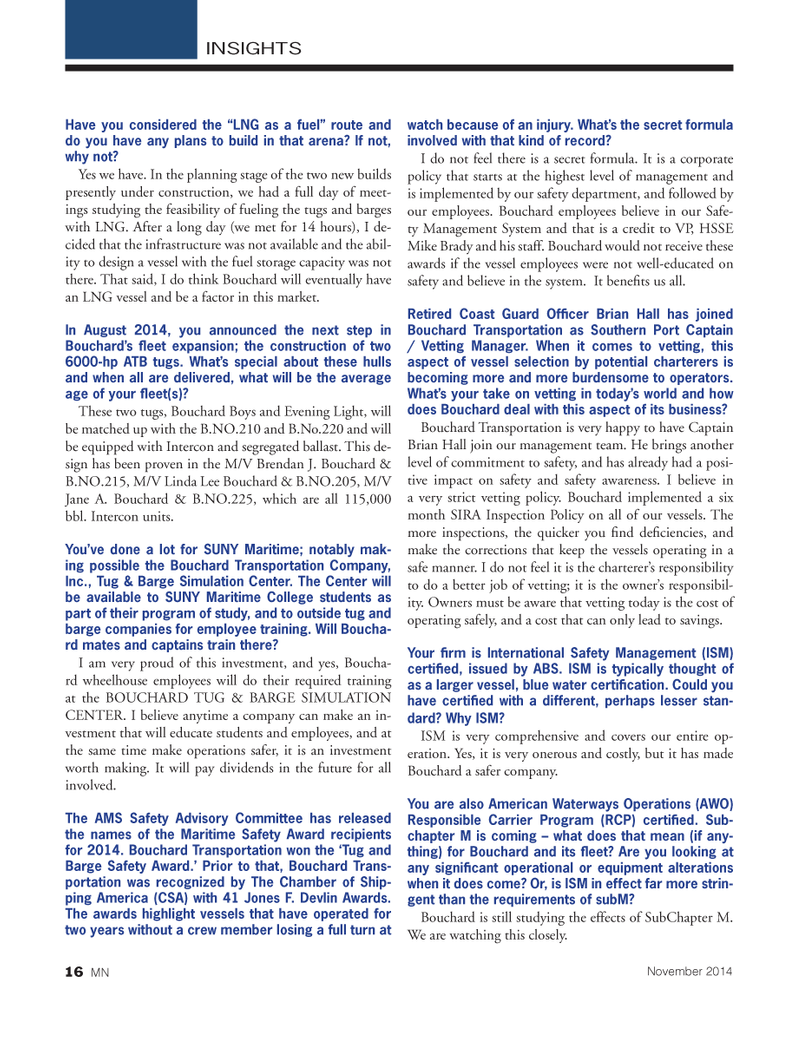
Page 16: of Marine News Magazine (November 2014)
Workboat Annual
Read this page in Pdf, Flash or Html5 edition of November 2014 Marine News Magazine
INSIGHTS
Have you considered the “LNG as a fuel” route and do you have any plans to build in that arena? If not, why not?
Yes we have. In the planning stage of the two new builds presently under construction, we had a full day of meet- ings studying the feasibility of fueling the tugs and barges with LNG. After a long day (we met for 14 hours), I de- cided that the infrastructure was not available and the abil- ity to design a vessel with the fuel storage capacity was not there. That said, I do think Bouchard will eventually have an LNG vessel and be a factor in this market.
In August 2014, you announced the next step in
Bouchard’s fl eet expansion; the construction of two 6000-hp ATB tugs. What’s special about these hulls and when all are delivered, what will be the average age of your fl eet(s)?
These two tugs, Bouchard Boys and Evening Light, will be matched up with the B.NO.210 and B.No.220 and will be equipped with Intercon and segregated ballast. This de- sign has been proven in the M/V Brendan J. Bouchard &
B.NO.215, M/V Linda Lee Bouchard & B.NO.205, M/V
Jane A. Bouchard & B.NO.225, which are all 115,000 bbl. Intercon units.
You’ve done a lot for SUNY Maritime; notably mak- ing possible the Bouchard Transportation Company,
Inc., Tug & Barge Simulation Center. The Center will be available to SUNY Maritime College students as part of their program of study, and to outside tug and barge companies for employee training. Will Boucha- rd mates and captains train there?
I am very proud of this investment, and yes, Boucha- rd wheelhouse employees will do their required training at the BOUCHARD TUG & BARGE SIMULATION
CENTER. I believe anytime a company can make an in- vestment that will educate students and employees, and at the same time make operations safer, it is an investment worth making. It will pay dividends in the future for all involved.
The AMS Safety Advisory Committee has released the names of the Maritime Safety Award recipients for 2014. Bouchard Transportation won the ‘Tug and
Barge Safety Award.’ Prior to that, Bouchard Trans- portation was recognized by The Chamber of Ship- ping America (CSA) with 41 Jones F. Devlin Awards.
The awards highlight vessels that have operated for two years without a crew member losing a full turn at watch because of an injury. What’s the secret formula involved with that kind of record?
I do not feel there is a secret formula. It is a corporate policy that starts at the highest level of management and is implemented by our safety department, and followed by our employees. Bouchard employees believe in our Safe- ty Management System and that is a credit to VP, HSSE
Mike Brady and his staff. Bouchard would not receive these awards if the vessel employees were not well-educated on safety and believe in the system. It benefi ts us all.
Retired Coast Guard Offi cer Brian Hall has joined
Bouchard Transportation as Southern Port Captain / Vetting Manager. When it comes to vetting, this aspect of vessel selection by potential charterers is becoming more and more burdensome to operators.
What’s your take on vetting in today’s world and how does Bouchard deal with this aspect of its business?
Bouchard Transportation is very happy to have Captain
Brian Hall join our management team. He brings another level of commitment to safety, and has already had a posi- tive impact on safety and safety awareness. I believe in a very strict vetting policy. Bouchard implemented a six month SIRA Inspection Policy on all of our vessels. The more inspections, the quicker you fi nd defi ciencies, and make the corrections that keep the vessels operating in a safe manner. I do not feel it is the charterer’s responsibility to do a better job of vetting; it is the owner’s responsibil- ity. Owners must be aware that vetting today is the cost of operating safely, and a cost that can only lead to savings.
Your fi rm is International Safety Management (ISM) certifi ed, issued by ABS. ISM is typically thought of as a larger vessel, blue water certifi cation. Could you have certifi ed with a different, perhaps lesser stan- dard? Why ISM?
ISM is very comprehensive and covers our entire op- eration. Yes, it is very onerous and costly, but it has made
Bouchard a safer company.
You are also American Waterways Operations (AWO)
Responsible Carrier Program (RCP) certifi ed. Sub- chapter M is coming – what does that mean (if any- thing) for Bouchard and its fl eet? Are you looking at any signifi cant operational or equipment alterations when it does come? Or, is ISM in effect far more strin- gent than the requirements of subM?
Bouchard is still studying the effects of SubChapter M.
We are watching this closely.
November 2014 16 MN
MN Nov14 Layout 1-17.indd 16 10/20/2014 2:44:33 PM

 15
15

 17
17
